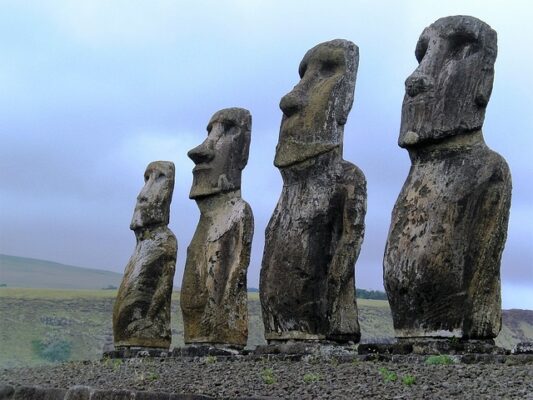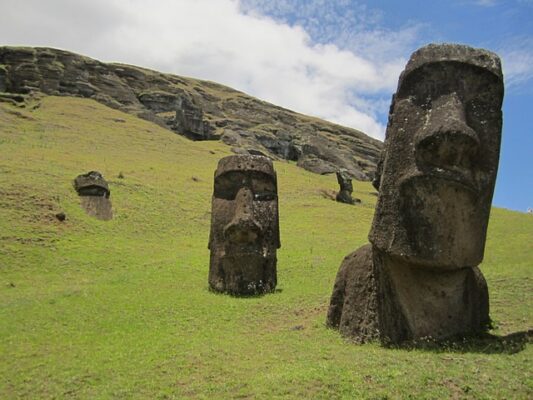Located at the southeastern part of the Pacific Ocean, Easter Island is one of the three island groups situated at the corner of Polynesian Triangle. The other two regions of this triangle are Hawaii and New Zealand. This island has a status of ‘special territory’ of the Republic of Chile. The most prominent feature of this Easter Island is the huge statues of human figures (made up of stones) that were carved out from 1100 to 1680 CE by the indigenous people. These statues are known as Moai. The native Polynesian language of this island is called Rapa Nui or Pascuan. The word ‘Rapa Nui’ literally means ‘Big Rapa’. For that reason, this island is also called island of Rapa Nui. Pitcairn Island is the nearest to this island occupied by people. It is located about 2,075 km away and inhabited by just about 100 people. Now let’s discover more about this historic island!
Official Name: Isla de Pascua
Alternative Name: Rapa Nui
First European to visit: Jacob Roggeveen
Annexation to Chile: 9 September, 1888
Designation: World Heritage Site (UNESCO)

History
- The first known traveler arriving on this island from Europe was a Dutch named Jacob Roggeveen. In 1722, he was looking for David’s island but he came across Easter Island along the way. That day was Easter Sunday and so, he named this island as Paasch-Eyland in Dutch which means ‘Easter Island.’
- The accounts of Roggeveen show that Rapa Nui people used to grow sweet potatoes, bananas and sugar cane on this island.
- This island was first inhabited in about 300 to 1200 CE.
- Rapa Nui people colonized this island between 700 and 1100 CE.
- It is assumed that Polynesians may have come from South America. This argument is backed up by the presence of sweet potato, which was the favorite crop of Polynesians. Sweet potato in turn was originated in South America.
- The Polynesians arrived on this island possibly from Mangareva Islands or perhaps from Marquesas Islands.
- At a time when people initially arrived, there were a lot of tree species on this island. But Polynesian rat has possibly destroyed plantation of these species.
- Until 1622, the population of Rapa Nui was estimated to be 15,000.
- In 1722, the island was occupied by just about 2,000 to 3,000 people. Moreover, almost all of the species of birds and 21 species of trees were also destroyed up to that time.
- Today, there are almost 4,000 inhabitants on this island. Most of them speak Spanish instead of their native language, Rapa Nui.
- The words of Rapa Nui language bear great resemblance to Mangareva language. Almost 80 percent of the words are similar in both languages. Mangareva is also a Polynesian language which is spoken by people living in Mangareva or Gambier islands.
- The trees were cut down on such a massive scale that the maximum height of trees on this island was just about 10 feet (3 metres) high. Due to this deforestation, seabirds became extinct and the crops were also affected since shadow of trees was no longer present due to their small size.
 Moai
Moai
- Easter Island is home to 887 moai.
- These statues are often referred to as ‘Easter Island heads’.
- Every statue was built by 5 to 6 people and took them one year to complete it.
- The head of each moai (or statue) was a symbol of head of lineage that had died.
- ‘Paro’ is the name of the biggest moai and it stands about 9.8 metres (32 feet) high.
- It takes about 200 to 250 people to move one moai from one place to another.
- More recently, 50 moai were built and the name of one such moai is Ahu Ature Huke. It was built in 1956 and situated on the sand beach of this island called Anakena.
- The stone platforms of moai are called Ahu.
- There are 313 known ahu (or stone platforms) on this island. Out of these, only 125 ahu contain moai.
- The largest ahu on this island is called Ahu Tongariki which is one kilometer in length. It contains the tallest moai. There are 15 statues on this platform and these were dug out in the 1990s.
- Ahu Akivi has seven moai. But the unique thing is that all of the moai of this ahu face Pacific Ocean. It was recovered in 1960 by an American anthropologist named William Mulloy.
- The heaviest moai weighs 86 tonnes and it is situated on Ahu Tongariki.
Leave a Reply